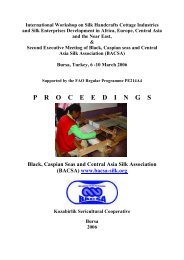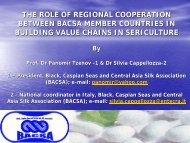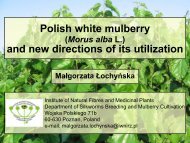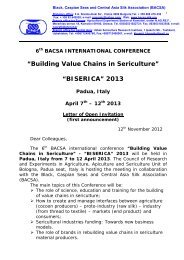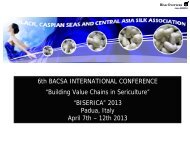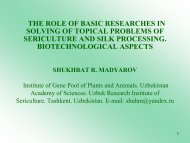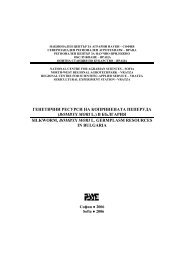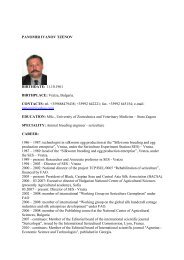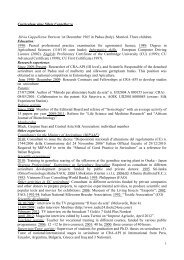Country report Greece - BACSA
Country report Greece - BACSA
Country report Greece - BACSA
Create successful ePaper yourself
Turn your PDF publications into a flip-book with our unique Google optimized e-Paper software.
Sericulture status, problems, issues and development<br />
strategies in <strong>Greece</strong><br />
Kipriotis Evripidis, M.Sc., Ph.D.<br />
National Agricultural Research Foundation<br />
(N.AG.RE.F.), Komotini Agricultural Research<br />
Station Merarhias Serron 18, Komotini 69 100,<br />
<strong>Greece</strong>.<br />
Paper contributed to the 6th <strong>BACSA</strong> International<br />
Conference<br />
“Building Value Chains in Sericulture” -<br />
“BISERICA” 2013, Padua, Italy, 7 - 12 April 2013.
Sericultural activities represent a long tradition in <strong>Greece</strong> and raw<br />
cocoon production and silk processing had been familiar activities of all<br />
the Greek territory since very early periods.
Production and processing reaches high levels in the country up to<br />
1938, highly affected by the silkworm’s s pembrine disease appearance<br />
in France, gaining a remarkable share among the Mediterranean<br />
countries.<br />
Fresh cocoon production in the Mediterranean basin, 1896-1934. 1934. (Tons)<br />
<strong>Country</strong><br />
Year<br />
1896 1904 1908 1912 1915 1922 1931 1934<br />
France 9.318 3.889 8.409 6.234 1.727 2.500 966 970<br />
Italy 41.182 56.641 53.193 47.470 33.897 30.000 34.458 28.839<br />
Spain 1.231 993 1.105 1.30 735 900 --- ---<br />
Austria – Hungary 3.599 3.756 3.953 3.482 1.730 1.500 --- ---<br />
Turkey 3.572 9.203 10.951 8.588 3.130 10.000 -- ---<br />
<strong>Greece</strong> 180 808 840 635 1.347 2.029 1.690 2.569<br />
Syria 4.860 5.119 5.641 4.660 4.050 5.500 2.815 3.310<br />
Sources: F.O. Diplomatic and consular <strong>report</strong>s, L’economiste L<br />
Francais, L’economista, L<br />
Economical <strong>report</strong>s of<br />
<strong>Greece</strong>.
Tons fresh cocoons<br />
60000<br />
50000<br />
40000<br />
30000<br />
20000<br />
10000<br />
France<br />
Italy<br />
Spain<br />
Austria-Hungary<br />
Turkey<br />
<strong>Greece</strong><br />
Syria<br />
0<br />
1908 1915 1922 1934
Dry cocoon production, consumption, exports, imports in<br />
<strong>Greece</strong> for the period 1920-1938, 1938, (tons)<br />
Year<br />
Dry cocoon<br />
production<br />
Dry cocoon<br />
consumption by<br />
the industry<br />
Dry cocoon<br />
exports<br />
Dry cocoon<br />
imports<br />
1921 460,9 140,0 282,3 ---<br />
1925 1.056,0 350,0 573,9 1,2<br />
1930 628,0 700,0 86,7 104,2<br />
1935 910,0 1.040,0 --- 153,5<br />
1938 1.149,2 1.000,0 30,8 2,6<br />
Sources: Statistics of the Greek commerce, National Statistics Secretariat S<br />
of <strong>Greece</strong>
For the same period, as a reflection to the international sericultural<br />
circumstances, silkworm egg production develops in <strong>Greece</strong>, reaching 140.000<br />
boxes (25 gr) yearly up to 1935, the biggest part of them exported, ed, mainly to<br />
Persia and Syria.<br />
Silkworm egg production, exports, imports in <strong>Greece</strong><br />
for the period 1920-1938 1938 (25 gr boxes)<br />
Year<br />
National<br />
production<br />
Exports<br />
Imports<br />
1921 53.041 --- 12.124<br />
1925 288.824 79.067 18.605<br />
1930 149.679 86.477 6.560<br />
1935 140.142 --- ---<br />
Sources: Statistics of the Greek commerce, National Statistics Secretariat S<br />
of <strong>Greece</strong>.
The above described situation lasted nearly up to 1940,<br />
followed after that by a dramatic decreasing caused by a<br />
combination of facts and coincidences as:<br />
• The Second World War and its<br />
dramatic socioeconomic effects.<br />
• The Greek civil war, right after the<br />
Second World War, and its<br />
dramatic effects to the Greek<br />
economy and social construction.<br />
• The development and dominance<br />
of low price synthetic fibers in the<br />
international market.<br />
• The rapid growth of the heavy<br />
industry and the follow up<br />
urbanization.<br />
• The gain of new crops, especially<br />
industrial ones, like cotton, sugar<br />
beet, maize and others, providing<br />
high mechanization and income.
As a result of the previously described situation all the well<br />
organized<br />
mulberry fields were gradually disappeared up to 1970 and the few<br />
maintained sericultural activities relied upon the numerous scattered<br />
tered<br />
mulberry trees existing all over the country.<br />
Sericulture reached almost zero point !!!!
Current issues in sericultural industries and silk enterprise<br />
development<br />
A brief Introduction<br />
In the last two decades a regain tendency of<br />
sericulture has been observed in <strong>Greece</strong>,<br />
deriving through some coincidences.
The main coincidences which affected the observed regain<br />
tendency of sericulture in <strong>Greece</strong> are summarized below<br />
• <strong>Greece</strong> became a full member of European Union (EU) and<br />
silkworm rearing activity within its Common Agricultural<br />
Policy, had been considered for some member countries,<br />
such as <strong>Greece</strong>, as one of the protected and promoted agro-<br />
industry components, being subsidized by around Euro 132<br />
per box of 20.000 eggs reared.<br />
• E.U. Common Agricultural policy also subsidized the<br />
replacement of traditional annual crops by perennial ones,<br />
like trees, including mulberry.<br />
• As a result of that some part of traditional annual crops,<br />
mainly industrial ones, like cotton, sugar beet, tobacco,<br />
maize, etc, has been replaced by mulberry, giving a stimulus<br />
for silkworm rearing.<br />
• The above two subsidies for some period provided a<br />
combined support for silkworm rearing, which actually<br />
stimulated the interest of some farmers and resulted to an<br />
increasing number of farmers involved and magnitude of<br />
rearing.
Main coincidences which affected the observed regain<br />
tendency of sericulture in <strong>Greece</strong>.<br />
• Silk reeling and processing industry could also be subsidized<br />
through national development programs, This fact actually caused<br />
the initiation of some silk industry development efforts in <strong>Greece</strong>,<br />
including the development of a cocoon reeling plant in Northern<br />
<strong>Greece</strong>, which appeared as very much promising for the involved in i<br />
sericulture people.<br />
• The high industrialisation and rapid development of some<br />
traditionally silk producing countries, like China, India and Korea,<br />
directed many farmers to industry and accordingly decreased the<br />
raw cocoon production, increasing simultaneously the demand of<br />
such countries for raw silk.<br />
• For a quite long period has been observed in the E.U. an increasing<br />
ing<br />
demand for natural and biological products. The silk products<br />
consumption steadily increased and for the same period also<br />
remarkably increased in <strong>Greece</strong>.<br />
• Sericulture recently had started being practiced also for the<br />
production of different than the traditional, high added value biob<br />
io-<br />
products, like pharmaceuticals, cosmetics and other biological<br />
substances, a fact creating more opportunities for its future.
In addition to the previously described factors, there can<br />
be distinguished some more specific advantages for<br />
sericultural development in <strong>Greece</strong>, like:<br />
• Silkworm rearing, is restricted, due to its climatic and<br />
environmental demands, only in the south temperate part of<br />
Europe<br />
• From this point of view <strong>Greece</strong> can be considered as one of the<br />
most suitable for rearing European regions, gaining from the<br />
advantage of EU subsidies for Sericulture.<br />
• There exists in the country a large proportion of marginal land,<br />
not suitable for intensive crops, but sufficiently suitable for<br />
mulberry cultivation.<br />
• In many areas of the country, especially in the tobacco<br />
producing ones, exist farming families with surplus of family<br />
labour capacity.<br />
• Due to the high tourism share in the country's economy, there<br />
are opportunities for the development of various silk product<br />
production and distribution centres, creating employment and<br />
additional income.<br />
• All new E.U. members from Balkan countries due to their<br />
geographic position could develop such centres, creating links<br />
and business between them, to the benefit of sericulture and<br />
economy.
Within these frames it appeared that sericulture could re-gain some of<br />
the lost ground and ensure a reasonable income through it.<br />
Simultaneously there could also be provided to the silk processing<br />
industry satisfactory raw material under reasonable prices.<br />
• The above facts for some<br />
period created an increasing<br />
interest among the Greek<br />
farmers and this interest was<br />
steadily increasing up to year<br />
2005 as:<br />
• Number of farmers<br />
involved<br />
• Silkworm egg boxes reared<br />
• Fresh cocoons produced<br />
• The most important<br />
point being the<br />
beginning of invested<br />
modern technology
This increasing tendency lasted up to year 2005 and there after<br />
remained unchanged or even decreased, especially in number of<br />
farmers involved.<br />
Various reasons, national and international, lead to these changes, the<br />
most important among them being the next:<br />
• The outbreak of the economic crisis in <strong>Greece</strong> and other E.U. countries<br />
created an environment not suitable at all for business expanding.<br />
• The dramatic energy cost increase of the last few years affected negatively<br />
the silkworm farmers, especially the modern ones, which invest a lot of<br />
energy in their rearing facilities, for heating, cooling, ventilation and cocoon<br />
cooking and drying.<br />
• The difficulties in bank financing for investment and business expansion.<br />
e<br />
• The uncertainness for the oncoming changes in the E.U. Common Agricultural<br />
Policy, reflecting to the possible loss of existing subsidies for r certain crops,<br />
which might include sericulture as well.<br />
• The decreasing demand for luxury products due to the outbreak of the<br />
economic crisis also reflected negatively on sericulture.<br />
• The dramatic changes in the E.U. textile industry, which was heavily affected<br />
in all E.U. countries and almost disappeared from some ones, like e <strong>Greece</strong>. The<br />
situation reflects to all of E.U. more or less, where most of the e industry<br />
stopped operating or moved to other counties with more favourable<br />
conditions.
Especially for <strong>Greece</strong> there existed some more specific factors<br />
which affected negatively sericulture’s s development.<br />
• The small number of farmers involved in<br />
sericulture and their scattered locations<br />
does not permit them to get organised in<br />
effective cooperatives, putting some<br />
press onto the political decisions for the<br />
benefit of their activity.<br />
• The complete lack of governmental<br />
support to silkworm farmers by means of<br />
specialized scientific personnel,<br />
specialised laboratories and advisory<br />
services. This situation exists for the last<br />
years and becomes worse due to the<br />
economic crisis.<br />
• The economic crisis, besides all other<br />
effects, resulted to a diminished<br />
economic support to all existing research<br />
structures.<br />
• The, years ago, started being developed<br />
cocoon reeling plant in northern <strong>Greece</strong><br />
was never completed, leaving behind the<br />
same difficulties to the Greek silkworm<br />
farmers.
Perhaps for the Greek reality, one of the most important<br />
factors, which interrupted the initial sericulture’s<br />
development, were the changes in the Agriculture’s<br />
Ministry policy, in relation to the silkworm egg provision.<br />
• Up to year 2009 the Ministry of<br />
Agriculture was holding centrally<br />
the provision of the silkworm eggs<br />
to the involved in sericulture<br />
farmers, purchasing the necessary<br />
amount through an international<br />
tender and distributing them,<br />
under a very low – almost symbolic<br />
price, to the farmers.<br />
• It has to be emphasized in this<br />
point that there does not exist<br />
local silkworm egg production in<br />
<strong>Greece</strong> and the whole country<br />
needs are covered by imports.
In 2009 it was announced that the farmers had to cover their silkworm<br />
egg need by themselves, covering all the costs.<br />
• Silkworm farmer numbers between<br />
reference year 2005 and year 2009-2010<br />
2010<br />
• This decision damaged<br />
seriously the already<br />
weak Greek sericulture,<br />
disappearing completely<br />
the small scale silkworm<br />
farmers.<br />
300<br />
250<br />
200<br />
150<br />
100<br />
50<br />
Farmers<br />
0<br />
2005 2009 2010
Area of the<br />
country<br />
Number of farmers<br />
involved in<br />
sericulture<br />
Year<br />
2009<br />
Year<br />
2010<br />
Total Number of<br />
silkworm egg<br />
boxes reared<br />
Year<br />
2009<br />
Year<br />
2010<br />
Mean Number of<br />
silkworm egg boxes<br />
reared per farmer<br />
Year<br />
2009<br />
Year<br />
2010<br />
Total amount of<br />
fresh cocoons<br />
produced (kgs)<br />
Year<br />
2009<br />
Year<br />
2010<br />
Mean amount of fresh<br />
cocoons produced per<br />
box of eggs (kgs)<br />
Year 2009 Year 2010<br />
Creta island<br />
(Chania) 34 0 54 0 1.58 0 1.108 0 20.51 0<br />
North <strong>Greece</strong><br />
(Orestiada)<br />
8 10 549 527 68.62 52.7 10.980 13.200 20.0 25.04<br />
North <strong>Greece</strong><br />
(Evros) 33 28 902 897 27.33 32.03 18.550 18.000 20.56 20.06<br />
North <strong>Greece</strong><br />
(Kavala) 3 3 300 345 100.0 115.09 6.000 6.600 20.0 19.13<br />
North <strong>Greece</strong><br />
(Serres) 13 12 929 1130 71.46 94.16 23.089 22.828 24.85 20.20<br />
Central <strong>Greece</strong><br />
(Evia) 1 0 20 0 20.0 0 415 0 20.75 0<br />
Greek islands<br />
(Lesvos) 126 0 248 0 2.96 0 4.960 0 20.0 0<br />
Totals 218 53 3.002 2.899 13.77 54.69 65.102 60.628 21.68 20.91
Total amount of fresh cocoons produced between<br />
reference year 2005 and year 2009-2010<br />
2010<br />
70.000<br />
68.000<br />
66.000<br />
64.000<br />
62.000<br />
60.000<br />
Fresh cocoons<br />
produced (kg)<br />
58.000<br />
56.000<br />
2005 2009 2010
Silkworm egg boxes reared per farmer between<br />
reference year 2005 and year 2009-2010<br />
2010<br />
60<br />
50<br />
40<br />
30<br />
20<br />
Silkworm egg<br />
boxes reared per<br />
farmer<br />
10<br />
0<br />
2005 2009 2010
So in relation to the reference year 2005 the evolution of the<br />
Greek sericulture for the last years is described below.<br />
Year<br />
Silkworm egg<br />
boxes reared<br />
Cocoon farmers<br />
involved<br />
Boxes reared<br />
per farmer<br />
Total fresh<br />
cocoon<br />
produced (tons)<br />
Mean cocoon<br />
prod/n per box<br />
(kg)<br />
2005 3.920 277 14,15 69 17,60<br />
2008 3.742 245 15,27 66 17,63<br />
2009 2.988 200 14,94 60 20,03<br />
2010 3.002 218 13,77 65 21,66<br />
2011 2.899 53 54,68 60 20,69<br />
2012 2.732 50 54,64 50 18,30<br />
Source: In the ISC web site does not appear data for the Greek fresh f<br />
cocoon production in the period 2008-2012, 2012, the last existing<br />
<strong>report</strong> being that of year 2007, giving a production of 104 tons. The data presented here are drawn from the Greek division of EU<br />
subsidies control (OPEKEPE).
Given as charts the data of the previous table<br />
are given in the following slides
Evolution of fresh cocoon production for the period<br />
2008-2012<br />
2012<br />
70<br />
60<br />
50<br />
40<br />
30<br />
Fresh<br />
cocoon<br />
produced<br />
(tons)<br />
20<br />
10<br />
0<br />
2008 2009 2010 2011 2012
Number of silkworm farmers for the period<br />
2008 – 2012<br />
250<br />
200<br />
150<br />
100<br />
Silkworm farmers<br />
50<br />
0<br />
2008 2009 2010 2011 2012
Number of silkworm egg boxes reared yearly for the<br />
period 2008 – 2012<br />
3.500<br />
3.000<br />
2.500<br />
2.000<br />
1.500<br />
1.000<br />
Egg boxes reared<br />
yerly<br />
500<br />
0<br />
2008 2009 2010 2011 2012
Of course the previous figures of the Greek raw cocoon appear<br />
very low, but they could be considered as significant, compared<br />
to the data of rest European countries, involved in Sericulture.<br />
Raw cocoon production of European countries (tons)<br />
<strong>Country</strong><br />
Year<br />
2007 2008 2009 2010 2011<br />
Bulgaria 55 48 51 75 49<br />
<strong>Greece</strong> 69 66 60 65 60<br />
France 0 0 0 0 0<br />
Italy 6 0 0 0 0<br />
Romania 4 5 25 0 0<br />
Turkey 130 126 140 129 151<br />
Source: ISC statistical data (except for <strong>Greece</strong> who’s s data are drawn from the Greek division of EU subsidies<br />
control - OPEKEPE)
Apart of the sericultural activities concerning primary production on (fresh<br />
cocoons), further activities around sericulture and silk processing<br />
appear as follows:<br />
• Due to the lack of cocoon reeling facilities in <strong>Greece</strong>, there does not<br />
exist any local raw silk production. As mentioned an initiated reeling r<br />
plant in Northern <strong>Greece</strong>, was never completed and its expected<br />
contribution to all Greek sericulture was never realized.<br />
• The only existing raw silk production is practiced by some small scale<br />
silk enterprises in Soufli, a small town in northern <strong>Greece</strong>. These are<br />
reeling, deguming, spinning, dying and waving small quantities,<br />
absolutely directed to a part of their needs, for local silk products. In<br />
total there are processed around 5 tons of raw cocoons yearly.<br />
• In general, the any existing silk product industry in <strong>Greece</strong>, covers its<br />
needs by imports of silk yarn, silk garments, silk fabrics and ready r<br />
made silk clothing. These are mainly intra E.U. imports and less from<br />
other than E.U. directions.
The above described situation in <strong>Greece</strong> in general<br />
reflects to the whole E.U. situation, which is absolutely<br />
based upon imports, some countries having the role of<br />
the main importers and distributors within E.U.<br />
<strong>Country</strong><br />
Dry cocoon<br />
Exports<br />
tons<br />
Silk imports-exports by E.U. countries<br />
Raw silk<br />
Exports<br />
tons<br />
Year 2011<br />
Twisted silk<br />
exports tons<br />
Dry cocoon<br />
Imports<br />
tons<br />
Raw silk<br />
Imports<br />
tons<br />
Twisted silk<br />
Imports<br />
tons<br />
Bulgaria --- --- 17 --- 9 ---<br />
France --- --- --- --- 108 ---<br />
Italy --- 357 393 --- 699 1764<br />
Switzerland --- --- 2 --- 5 3<br />
Turkey 68 19 8 --- 93 86<br />
Source: ISC statistical data
The whole today's structure of the silk industry in E.U. has to be<br />
considered in relation to the general textile and clothing sector,<br />
which faces a strong crisis in the last years.<br />
• The sector in 1998 amounted a turnover of 198 bn euros, and accounted 2,3<br />
million workers employed in 150.000 small and medium scale enterprises.<br />
• Up to 2009 due to the economic crisis, the sector’s s turnover dropped to 167<br />
bn. Euros, decreasing by 28%, and the people employed by it almost halved.<br />
• Today the bigger producers in this field are Italy, Germany, France, Spain and<br />
U.K., sharing almost 75% of the total E.U. activity.<br />
• In some other countries, like Portugal, <strong>Greece</strong>, Lithuania, Poland, d, Slovakia,<br />
Romania, Bulgaria and Czech Republic, the sector has been playing g an<br />
important role in the economy, accounting in the past 5-15% 5 15% of the<br />
employment and around 10% of total exports of manufactured products.<br />
• Since 2009 the sector’s s tendency generally in E.U. is a slow recovering, but in<br />
some countries, including <strong>Greece</strong>, it is still very severely affected, having lost<br />
the biggest part of its enterprises, the most of the closed or transferred t<br />
to<br />
other countries.
Existing situation in the country by means of sericultural<br />
institutes, government offices in charge of cocoon and<br />
silk production, research and extension systems.<br />
• As an important fact in this description has to be pointed that the<br />
ongoing economic crisis resulted to the diminished financing of all<br />
existing advisory and research structures of the country.<br />
• The already, for long time existing, lack of governmental support t to<br />
silkworm farmers, by means of specialized scientific personnel,<br />
specialised laboratories and advisory services, became even worse<br />
and today there is not absolutely existing any structure able to<br />
support and promote sericulture.<br />
• The research activities of the any existing institutions have<br />
dramatically declined, their specialised personnel is directed to t<br />
unemployment and is never replaced and there is obvious the risk of<br />
complete inactivity or even complete disappearance of them.
More specifically<br />
• The only existing specialised in sericulture institution, the Komotini Agricultural research<br />
Station, has been already left without researchers and remains to a diminished financing,<br />
unable to maintain even its routine activities, as the maintenance of its silkworm gene<br />
bank.<br />
• The peripheral divisions of the Ministry of Agriculture undergo the same situation. Their<br />
support to sericulture was already of no significance, dealing only o<br />
with administration<br />
routines around the E.U. subsidies. Finally even this activity was transferred to the<br />
general administration and subsidies control service (OPEKEPE), and there after there<br />
isn’t t left any significant ministry’s s activity, directly connected to advise, aid and<br />
promotion of sericulture.<br />
• The still existing ‘’Sericultural Laboratory of Athens’’<br />
’’,, a branch of the Ministry of<br />
Agriculture hosted by the Agricultural University of Athens, according to the existing law<br />
since 1910, only deals centrally with the quality control of all the imported silkworm eggs<br />
in all areas of <strong>Greece</strong>, creating a complicated interfering, long time consuming and<br />
causing numerous problems to the farmers.
As it comes out of all the above facts, today there aren’t<br />
actually any significant and sufficient governmental<br />
structures in the country, targeting to a strategy for the<br />
development of sericulture.<br />
• The existing farmers actually remain without<br />
specialised scientific and technical support, relying<br />
absolutely upon their experience and the aid of the<br />
very-very few existing specialised scientists.<br />
• In addition the possibilities for their organization to<br />
strong and active cooperatives are minimal, removing<br />
in this way even the chances for an internal by their<br />
organization support.
Concerning any thoughts about the future of sericulture<br />
in the country, it seems very difficult to go through any<br />
predictions. It could though be an attempt to this<br />
direction taking in consideration the next facts:<br />
• The international prices of cotton, which is the main crop in <strong>Greece</strong>, steadily fall the last<br />
years, something which combined with the increasing cost of inputs to this crop, affects<br />
negatively its future.<br />
• Tobacco, another important crop of the country, faces grate problems, either as crop or<br />
as processing industry. Its prices continuously fall and its high h labor demand makes it<br />
very unattractive for the farmers.<br />
• E.U. subsidies for the main country’s s crops will most possibly dramatically decrease after<br />
year 2014, according to the new C.A.P., reflecting negatively to their income.<br />
• Tourism seems to gain bigger shares and bigger importance in the national economy,<br />
predicting the development and increase of small handcrafts industries.<br />
• The increasing rates of unemployment, due to the economic crisis, , direct many people,<br />
especially young, to seek various activities for the creation of some income.<br />
• Cocoon production in traditionally leading countries, like China, , Korea and India, are<br />
steadily falling due to the rapid industrialization of them, the result being the incomplete<br />
coverage of their industry’s s demands for raw silk materials.<br />
• This situation directly reflects to other silk processing countries, especially those dealing<br />
with carpet waving, where appears also an increasing demand for raw silk materials.
Considering all the above facts in combination, it comes out that t there<br />
could be presumed an opportunity for sericulture’s s implication in<br />
solving some of the existing problems, by means of efficient land d and<br />
labor use, income sufficiency, rural development and export<br />
possibilities.<br />
Of course this opportunity should be urgently<br />
and sufficiently covered by some central<br />
governmental actions targeting to:<br />
• Efficient coverage of the cocoon farmers with training<br />
• Technical support<br />
• Disease control<br />
• Promotion and use of existing national silkworm and mulberry<br />
resources<br />
• Cooperative organization for cocoon trade, cocoon reeling,<br />
and silk processing
It becomes obvious that all the above described facts have to<br />
be faced through a long term, carefully planed national<br />
programme, within a general E.U. frame.<br />
• Under the today formed situation<br />
though, and the appeared<br />
economic crisis, it seems to be<br />
more than optimistic to expect<br />
such actions and hope sericulture<br />
to grow soon in <strong>Greece</strong><br />
• It is certain though, that there are<br />
specific favourable conditions<br />
promising a potential for<br />
sericulture’s s development in the<br />
country.<br />
• For sure the next few years will<br />
form new frames on the economic<br />
reality of <strong>Greece</strong> and other<br />
European countries as well, which<br />
will for sure affect the future of<br />
sericulture.
It is desirable of course to study in advance the formed<br />
situation and predict future actions, but this seems today<br />
extremely difficult, especially concerning the future of<br />
sericulture. There are arising questions very difficult to be<br />
answered, like:<br />
• What will be the economic situation for the next years?<br />
• Which will be the changes in the E.U. Common Agricultural<br />
Policy?<br />
• Which will be the priorities on national and international<br />
level?<br />
• Which will be the energy cost development for the next<br />
years?<br />
• Which will be the share of luxury silk products in a world<br />
under economic crisis?
Taking such questions in consideration it is really difficult<br />
to speak about national or even European strategies for<br />
the sericulture’s s development.<br />
• The next few years are going to be very<br />
critical, and the only certain thing is that<br />
there are going to be realized many big<br />
changes in the agricultural, processing and<br />
trade reality of many countries.<br />
• The direction and the magnitude of these<br />
changes will create the future of sericulture<br />
in tomorrow’s s Europe.
So let us hope for the best !!!!!
Thank you very much for<br />
your attention.



